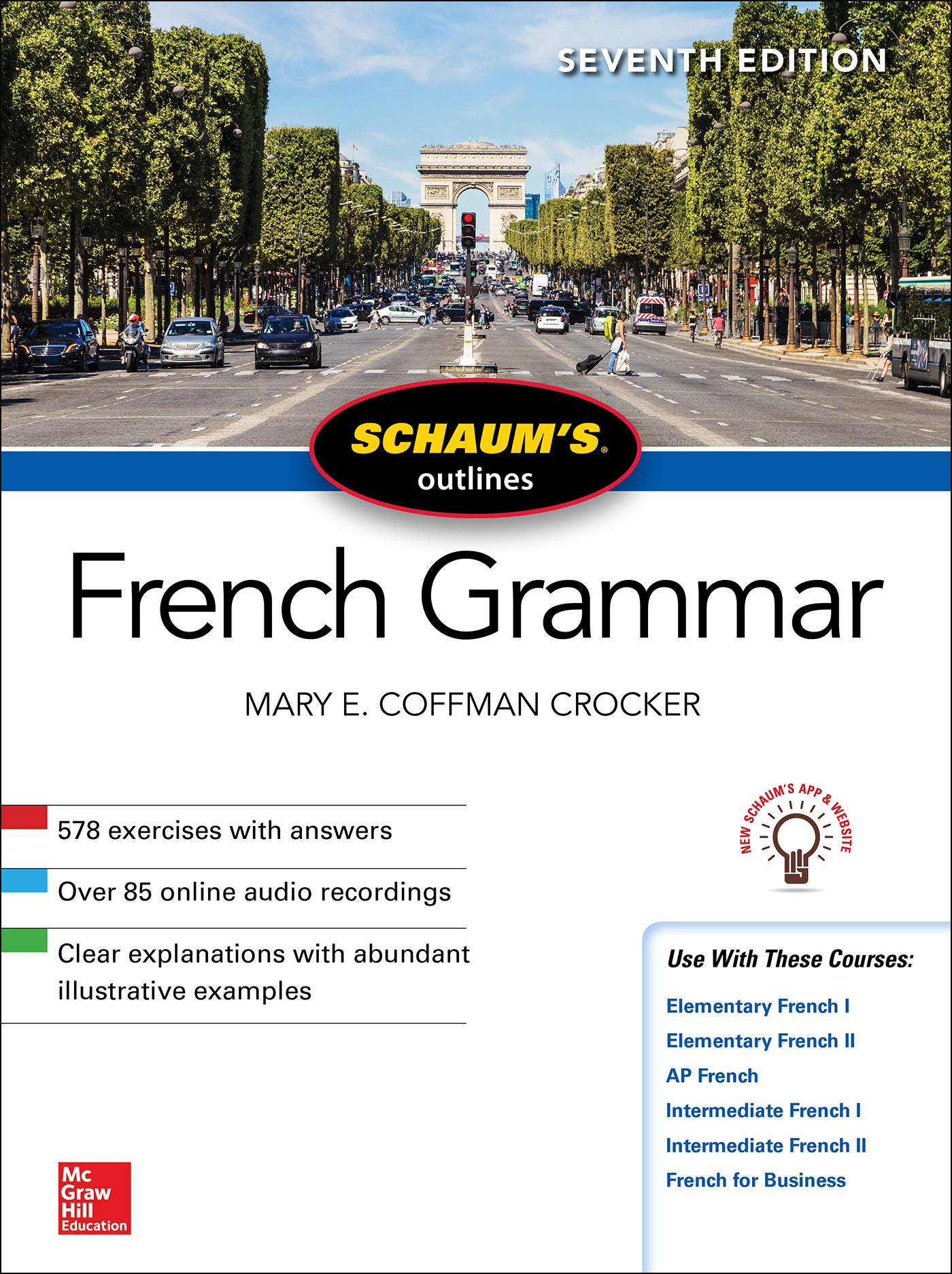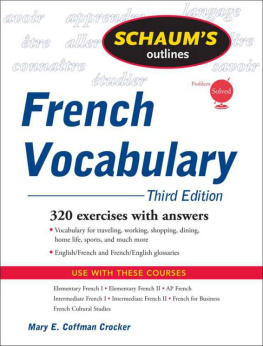Contents
Guide
Page List

 MARY E. COFFMAN CROCKER
MARY E. COFFMAN CROCKER is a French editor, author, and consultant in Toronto, Ontario. She was previously Senior Editor, French as a Second Language, Copp Clark Pitman, Toronto, Ontario; Directrice des ditions, Langues Secondes, Centre ducatif et Culturel, Montral, Qubec; and Sponsoring Editor, Foreign Language Department, McGraw-Hill Book Company, New York, New York. She is also the author of
Schaums Outline of French Vocabulary, Fourth Edition and a biographee in
Whos Who of American Women, Ninth Edition. Copyright 2018 by McGraw-Hill Education. All rights reserved.
Except as permitted under the United States Copyright Act of 1976, no part of this publication may be reproduced or distributed in any form or by any means, or stored in a database or retrieval system, without the prior written permission of the publisher. ISBN: 978-1-26-012096-7
MHID: 1-26-012096-1 The material in this eBook also appears in the print version of this title: ISBN: 978-1-26-012095-0,
MHID: 1-26-012095-3. eBook conversion by codeMantra
Version 1.0 All trademarks are trademarks of their respective owners. Rather than put a trademark symbol after every occurrence of a trademarked name, we use names in an editorial fashion only, and to the benefit of the trademark owner, with no intention of infringement of the trademark. Where such designations appear in this book, they have been printed with initial caps. McGraw-Hill Education eBooks are available at special quantity discounts to use as premiums and sales promotions or for use in corporate training programs.
To contact a representative, please visit the Contact Us page at www.mhprofessional.com. Trademarks: McGraw-Hill Education, the McGraw-Hill Education logo, Schaums, and related trade dress are trademarks or registered trademarks of McGraw-Hill Education and/or its affiliates in the United States and other countries and may not be used without written permission. All other trademarks are the property of their respective owners. McGraw-Hill Education is not associated with any product or vendor mentioned in this book. TERMS OF USE This is a copyrighted work and McGraw-Hill Education and its licensors reserve all rights in and to the work. Use of this work is subject to these terms.
Except as permitted under the Copyright Act of 1976 and the right to store and retrieve one copy of the work, you may not decompile, disassemble, reverse engineer, reproduce, modify, create derivative works based upon, transmit, distribute, disseminate, sell, publish or sublicense the work or any part of it without McGraw-Hill Educations prior consent. You may use the work for your own noncommercial and personal use; any other use of the work is strictly prohibited. Your right to use the work may be terminated if you fail to comply with these terms. THE WORK IS PROVIDED AS IS. McGRAW-HILL EDUCATION AND ITS LICENSORS MAKE NO GUARANTEES OR WARRANTIES AS TO THE ACCURACY, ADEQUACY OR COMPLETENESS OF OR RESULTS TO BE OBTAINED FROM USING THE WORK, INCLUDING ANY INFORMATION THAT CAN BE ACCESSED THROUGH THE WORK VIA HYPERLINK OR OTHERWISE, AND EXPRESSLY DISCLAIM ANY WARRANTY, EXPRESS OR IMPLIED, INCLUDING BUT NOT LIMITED TO IMPLIED WARRANTIES OF MERCHANTABILITY OR FITNESS FOR A PARTICULAR PURPOSE. McGraw-Hill Education and its licensors do not warrant or guarantee that the functions contained in the work will meet your requirements or that its operation will be uninterrupted or error free.
Neither McGraw-Hill Education nor its licensors shall be liable to you or anyone else for any inaccuracy, error or omission, regardless of cause, in the work or for any damages resulting therefrom. McGraw-Hill Education has no responsibility for the content of any information accessed through the work. Under no circumstances shall McGraw-Hill Education and/or its licensors be liable for any indirect, incidental, special, punitive, consequential or similar damages that result from the use of or inability to use the work, even if any of them has been advised of the possibility of such damages. This limitation of liability shall apply to any claim or cause whatsoever whether such claim or cause arises in contract, tort or otherwise.
PREFACE
This review book has been designed and developed in order to facilitate the study of French grammar. The book is divided into nine chapters.
Each one concentrates on the basic problem areas of the language: nouns and articles; adjectives and adverbs; prepositions; numbers, dates, and time; verbs; interrogatives; negatives; pronouns; and special meanings of certain verbs. Each grammatical or structural point is introduced by a simple explanation in English. The explanation is further clarified by many concrete examples. It is recommended that you first read the explanation and then study the illustrative examples. You should then write out the answers to the exercises that follow. You should rewrite the entire sentence in fill-in-the-blank exercises even though only one or two words are required.
It is recommended that you correct yourself immediately before proceeding to the next exercise. An answer key appears at the end of the book. Many of the exercises involve authentic, meaningful contexts and practical, real-life situations to which students can relate. Some of the exercises will require you to understand meaning as well as form in order to successfully complete them. Other exercises provide for openended and personalized answers. These exercises will help you develop proficiency in French and prepare for communicative activities in your classroom.
One of the most difficult and tedious tasks in acquiring a second language is learning the many forms that exist in the language, whether they are noun, adjective, or verb forms. In Schaums Outline of French Grammar, all forms have been logically grouped in order to make their acquisition as simple as possible and also to minimize what at first appear to be irregularities. In many texts, the verbs courir, rire, rompre, and conclure are treated as separate irregular verbs in the present tense. You will note, however, that these verbs have a lot in common. The same endings as those for regular -re verbs are added to the infinitive stem except in the third person singular: couriril court, je cours, tu cours, nous courons, vous courez, ils courentrireil rit, je ris, tu ris, nous rions, vous riez, ils rientrompreil rompt, je romps, tu romps, nous rompons, vous rompez, ils rompentconclureil conclut, je conclus, tu conclus, nous concluons, vous concluez, ils concluent This can be done with many verbs in all tenses. Schaums Outline of French Grammar can be used as a review text, as a companion to any basic text, or as a reference book. Schaums Outline of French Grammar can be used as a review text, as a companion to any basic text, or as a reference book.
In order to reinforce each point you are learning in your basic text, you may wish to get additional practice by doing the clear, logically organized exercises provided throughout this book. Each chapter contains review exercises. These sections are indicated by the gray bar in the outer margin. See the inside ad to find directions on downloading a companion audio recording. Based on selected material () from the answer key, you can use this recording to practice your French comprehension and pronunciation skills. New to this edition are French typographical rules.




 MARY E. COFFMAN CROCKER is a French editor, author, and consultant in Toronto, Ontario. She was previously Senior Editor, French as a Second Language, Copp Clark Pitman, Toronto, Ontario; Directrice des ditions, Langues Secondes, Centre ducatif et Culturel, Montral, Qubec; and Sponsoring Editor, Foreign Language Department, McGraw-Hill Book Company, New York, New York. She is also the author of Schaums Outline of French Vocabulary, Fourth Edition and a biographee in Whos Who of American Women, Ninth Edition. Copyright 2018 by McGraw-Hill Education. All rights reserved.
MARY E. COFFMAN CROCKER is a French editor, author, and consultant in Toronto, Ontario. She was previously Senior Editor, French as a Second Language, Copp Clark Pitman, Toronto, Ontario; Directrice des ditions, Langues Secondes, Centre ducatif et Culturel, Montral, Qubec; and Sponsoring Editor, Foreign Language Department, McGraw-Hill Book Company, New York, New York. She is also the author of Schaums Outline of French Vocabulary, Fourth Edition and a biographee in Whos Who of American Women, Ninth Edition. Copyright 2018 by McGraw-Hill Education. All rights reserved.